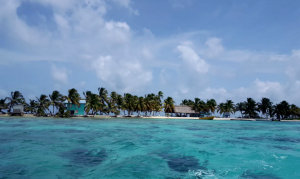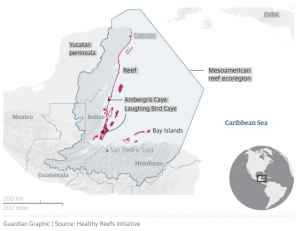Spectacular rebirth of Belize’s coral reefs threatened by tourism and development
 By Nina Lakhani in Laughing Bird Caye, Belize From The Guardian UK
By Nina Lakhani in Laughing Bird Caye, Belize From The Guardian UK
Report reveals improvement but also details danger posed by tourist-generated pollution, oil extraction and climate change
Just below the surface of the turquoise sea, coral flutters majestically amid schools of puffed up porcupinefish and fluorescent blue and yellow angelfish.
The gangly staghorn and fanning elkhorn corals are thriving in swimming distance of Laughing Bird Caye, a tiny Caribbean sandy islet in southern Belize, thanks to a restoration project that is yielding striking results.
More than 90,000 corals grown in sea nurseries have been planted in shallow reefs, increasing coral cover in these southern warm waters by 35%. Marine creatures are reproducing, and about 90% have survived natural and manmade pressures for almost a decade.
Hailed as the most impressive coral reef restoration effort in the Caribbean, its success is linked to a grassroots movement uniting fisherman, tour guides, scientists and environmentalists working to conserve the 700-mile Mesoamerican Reef (MAR) – the second largest barrier reef in the world.
For the past decade this interconnected reef – which stretches from Mexico’s Yucatán peninsula to the Bay Islands of Honduras – has been monitored by the Healthy Reefs for Healthy People Initiative (HRI). At more than 300 sites in Mexico, Belize, Honduras and Guatemala, scientists measure coral cover, fish stocks and fleshy macroalgae – a nuisance seaweed which competes for space with coral.
And despite the huge threats posed by pollution and climate change, a forthcoming HRI report will reveal steady improvements in the overall health of the MAR. Coral cover has risen from 10% to 17.5% since 2006 – far from great, but much healthier than many other reefs.
“This is a David versus Goliath battle in which we haven’t yet been squashed,” said HRI founder Melanie McField with the Smithsonian Institution. “Working at a targeted local and regional level has helped the MAR hold its own and withstand major threats outside our control.”
But the HRI report, to be published next month, also reveals challenges threatening the reef. In particular, fleshy macroalgae is flourishing at the expense of coral due to rising contamination and dwindling fish stocks.
In Belize – once regarded as a visionary in marine management – the reef is threatened by hotel resorts, inadequate law enforcement and oil extraction.
Unesco declared Belize’s barrier reef system a World Heritage site in 1996. Its diverse ecosystem hosts more than a thousand low-lying islands, the Blue Hole – a pristine 144-metre (472ft) sinkhole surrounded by coral reef – and 1,400 species of flora and fauna.
Conservation is crucial for this tiny central American country, as around half the population, or 180,000 people, depend on tourism from diving, snorkelling and fishing. The reef generates around 15% of Belize’s GDP.
But the unbridled sell-off of cayes within so-called marine protected areas, the destruction of mangroves, overfishing and agricultural runoffs have seriously damaged the Belize reef, which has been on the world heritage danger list since 2009.
Laughing Bird Caye lies 12 miles from the southern tip of the scenic Placencia Peninsula, a long land strip which snakes between the sea and a huge lagoon. The vistas, however, are blighted by densely packed hotels, holiday homes, and half-built lodgings abandoned when foreign investment ran dry.
Visitor numbers have surged in recent years, and the toilets on Laughing Bird Caye cannot always cope, so human waste spills into the sea.
“In a marine protected area in a world heritage site; surely waste management should be a priority,” said marine biologist Lisa Carne from Fragments of Hope, which leads the coral restoration project.
A couple of miles south of the peninsula is Harvest Caye, an island sold to a Norwegian cruise line company which drops off thousands of passengers every month.
The sale went through despite the government’s own guidelines warning against megaprojects in the area. Environmentalists blame increased boat traffic for a spike in manatee deaths.
The supreme court ruled that the environmental impact assessment was flawed and community consultations inadequate. The ruling set an important legal precedent – but came too late to stop the cruise island.
According to Nadia Bood, the World Wildlife Fund’s reef scientist in Belize, too many tourism projects are approved contrary to environmental regulations.
“We’ve got some good laws, which aren’t implemented, and some very outdated ones, where fines for infractions are too low, and there is too much self-monitoring …to protect the Belize reef system the current development pattern has to change,” she said.
Non-compliance is a recurring theme: in 2009, Belize was praised for laws designed to tackle overfishing. These created no-take and no-fishing zones in biodiversity hot spots and a complete ban on fishing grazers like the brilliantly coloured parrotfish. Grazers eat the fleshy macroalgae, so when numbers decline, so does coral cover.
But the law is not universally enforced.
The central section of the Belize reef is the only MAR zone rated “critical” by HRI, largely on account of dangerously low fish stocks. In the southern reef, which includes Laughing Bird Caye, commercial and grazer fish stocks are twice the regional average as no-fishing rules are better enforced.
But environmentalists fear that Placencia Peninsula is repeating mistakes made on San Pedro town on Ambergris Caye – widely regarded as an example of how not to develop.
Reached by ferry from Belize City, San Pedro has morphed from a sleepy fishing village into the country’s most popular tourist destination where holidaymakers descend to dive, snorkel, fly fish and party. There are no cars on the island, but the grumble of golf buggies is loud and constant.
Visitors produce too much rubbish and waste for the island’s inadequate infrastructure to handle. Consequently, a third of the reef here is covered in fleshy macroalgae – the worst rate in the MAR; cover coral is only 12%.
San Pedro also illustrates another dangerous consequence of unchecked development: mangrove destruction.
Mangroves, coastline woody shrubs and miniature trees, are complex ecosystems in their own right and vital for healthy reefs. The long snaky roots support and buffer sandy shores, and act as giant nurseries for young fish.
Almost no mangroves remain around San Pedro as developers cull the amphibious forests to leave sandy beaches. The island is fenced by artificial sea walls, rebuilt increasingly higher to try shield it from big waves.
New regulations promised in March to restrict mangrove clearance on private and public lands promised have yet to appear.
“Development has gone way beyond the island’s capacity,” said Billy Leslie, president of national tour guides association. “The government either doesn’t have the right experts, or the experts are telling them what they want to hear.”
The MAR last suffered a major bleaching event in 1998, but it remains a constant threat. In addition, a new, potentially catastrophic threat hovers over Belize: oil.
In 2015, leaked documents revealed that offshore oil exploration licences affecting several marine protected areas were secretly issued a few years earlier.
The government subsequently promised to introduce a ban protecting the Unesco site and a 1km buffer around the reef, a proposal widely derided as unworkable given it would only cover a seventh of the sea. The closest clean-up equipment in Jamaica would take three days to reach an oil spill here.
But even this half-hearted ban hasn’t been implemented; the temporary moratorium could be lifted at any moment.
“Oil and healthy reefs are not compatible,” said McField from HRI. “A spill would be an onslaught on conservation and restoration efforts, the risk is so not worth it.”
For more information on the reef condition in Belize look for the upcoming 2017 Mesoamerican Reef Report Card at www.healthyreefs.org in late September
Since you’re here …
… we have a small favour to ask. More people are reading the Guardian than ever but advertising revenues across the media are falling fast. And unlike many news organisations, we haven’t put up a paywall – we want to keep our journalism as open as we can. So you can see why we need to ask for your help. The Guardian’s independent, investigative journalism takes a lot of time, money and hard work to produce. But we do it because we believe our perspective matters – because it might well be your perspective, too. Go to weblink below to subscribe
IMAGES:
Increasing tourist numbers to Laughing Bird Caye is putting pressure on the tiny island’s sanitation services. Photograph: Nina Lakhani
Coral reefs in Laughing Bird Caye. Photograph: Fragments of Hope/Lisa Carne
For more on this story go to; https://www.theguardian.com/environment/2017/aug/22/belize-coral-reefs-improving-grassroots-restoration







